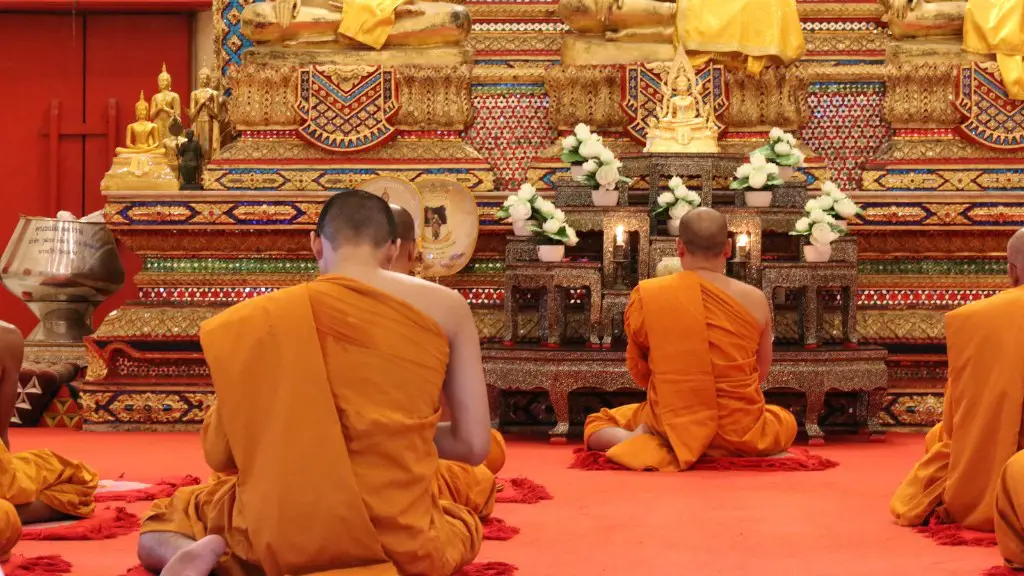Hinduism is among the oldest and most widely practiced religions in the world, with adherents in dozens of countries across the globe. It is a religion made up of a variety of different beliefs, practices and customs that all have their roots deeply rooted in India, which is why it is still largely practiced in India today. But where else is Hinduism practiced? The answer is that Hinduism continues to spread, affecting the lives of devotees in Southeast Asia, South Asia, and the United States.
In India, Hinduism is the dominant religion, practiced by over 80% of the population. This number is likely even higher because some people in India practice Hinduism in combination with other religions, such as Islam and Christianity. Additionally, Hinduism continues to spread within India and to other countries, with thousands of new converts each year.
Nepal is another country where Hinduism is very strong. This is largely due to Nepal’s long history of being immersed in the Indian culture that Hinduism is deeply intertwined with. Additionally, some of Hinduism’s religious practices and festivals are officially recognized in Nepal, making the religion just as strong in this country as it is in India.
Southeast Asian countries, such as Malaysia, Singapore, and Indonesia, also have Hindu populations. The main reasons for these countries’ Hindu populations are due to the Indian diaspora, or the migration of Indian people to those countries over centuries. These communities of Indian people have kept Hinduism alive in these countries, and their presence is still visible in festivals, temples, and other cultural expressions.
Hinduism continues to spread outside of Asia as well. In the United States, Hinduism is the fourth largest religion after Christianity, Islam, and Judaism. This is mainly due to the growth of the Indian diaspora in the US. There are estimated to be around three million Hindus living in the United States, with most of them living in the larger urban centers like New York City, Los Angeles, and San Francisco.
It is clear that Hinduism is not only alive and well in India, but that it is continuing to spread to other countries and regions around the world. That said, it is also true that the religion has evolved over centuries as its adepts followed the Indian diaspora. For example, Hinduism has managed to adapt to the vastly different cultural expressions in Southeast Asia, and is slowly becoming a part of the US cultural landscape as well.
Overall, Hinduism is a religion that has managed to spread over centuries to long distances and vastly different cultures. It is still practiced in India, the birthplace of the religion, but it is also constantly evolving and growing in new places.
Adaptation of Hinduism in Remote Locations
As Hinduism spread beyond India, it had to adapt to vastly different cultural expressions in remote locations. This adaptive process helped the religion to maintain relevance and coherence in different parts of the world, as different adherents interpreted Hindu practices, rituals, and beliefs in different and often creative ways.
For example, Hinduism in the Caribbean and Latin America has been influenced by the region’s African, Amerindian, and Spanish Catholic cultures. With the syncretism that results, there are now both Hindu and Catholic devotees across the region. Syncretism means a combination of two or more religions, leading to a unique expression of the religion in the region.
In the United States, new Hindu denominations have emerged, adapting the faith to the local cultural context. For example, the Hare Krishna movement was established in New York City in the mid-1960s and quickly found its adherents among the hippie youth of the time. This movement reimagined traditional Hindu beliefs to suit the new cultural surroundings, resulting in a new and vibrant form of Hinduism that is practiced today in both the US and India.
Furthermore, Hinduism in the US has also influenced other religious denominations, with yoga, ayurveda, and meditation being adopted by a wide range of faiths. This shows that the Hindu faith has been able to adapt and be accepted in many different contexts, making it one of the most successful religions worldwide.
Hinduism in the Digital Age
Since the rise of the digital age, Hinduism, as well as other world religions, has embraced technology and become more available than ever before. With the internet and social media, Hinduism has been able to reach many more people than before and spread its teachings, practices, and beliefs to corners of the globe that were previously unreachable.
On the internet, there are now many online communities, websites, and forums devoted to Hinduism. Devotees can watch lectures and interviews with prominent scholars, write and read blogs, join virtual congregations, and even learn to meditate. Additionally, there are multiple Hindu grant-making organizations operating online, raising money and supporting projects to help propagate Vedic knowledge around the world.
Finally, technology has also enabled Hindu organizations to spread the message of peace and non-violence associated with the faith across the world. Organizations like the International Society for Krishna Consciousness (ISKCON) now use websites, videos, cartoons, and other digital tools to convey the beliefs of the religion in an engaging and interactive way.
Hinduism in the 21st Century
As we enter the 21st century, Hinduism is becoming an increasingly global phenomenon, with adherents in various countries around the world. This has led to an expansion of the faith’s reach, allowing people of all backgrounds to experience the culture, beliefs, and practices of Hinduism.
Additionally, organizations like the Global Alliance for Hindi Studies, the Hindu American Foundation, and the Dharma Civilization Foundation have worked to establish Hinduism as a distinct world religion through advocacy, research, and education. This recognition helps ensure that Hinduism is not left out of the conversation in an increasingly secularized world, and is contributing to the growth of awareness and acceptance of the religion in the Western world.
Lastly, the spread of Hinduism has been aided by the growth of yoga and meditation practices, both of which are integral parts of the faith. As more and more people discover the benefits of these practices, the interest in Hinduism is expected to continue growing in the future.
Criticism of Hinduism
Despite the immense appeal and worldwide presence of Hinduism, the faith has also been subjected to criticism from both within and outside its own ranks. For example, the caste system and its oppression of the lower castes has been widely criticized as a form of injustice and discrimination. Additionally, the proliferation of Hindu nationalism in India, which is focused on protecting the Hindu identity, has been attacked as a form of sectarianism and bigotry.
Furthermore, Hinduism has been criticized for its lack of gender equality, as well as its cultural appropriation of other religions and traditions. Some religious scholars have also accused the faith of being overly ritualistic, with certain practices and beliefs being seen as outdated and irrelevant in modern times.
Despite these criticisms, however, Hinduism continues to be one of the world’s oldest and most widely practiced religions. With its adaptable and diverse teachings and practices, the faith continues to attract millions of devotees, who see the religion as an integral part of their lives and identities.
Impact on Indian Culture
Despite the worldwide spread of Hinduism, the faith remains deeply rooted in Indian culture. The presence of Hinduism in India is embodied in its art, music, architecture, philosophy, and literature. Additionally, the spiritual and religious beliefs of Hinduism are integral to the ethical values of many Indian citizens.
Furthermore, Hinduism continues to inform Indian public policy, from the protection of cows and traditional marriage practices, to the veneration of religious sites like the Tirupati Temple. The religion has also shaped the way people view their relationship to the environment, with many Indian Hindus following the faith’s teachings to help protect the land and promote sustainable development.
Lastly, Hinduism continues to be part of India’s national identity, with many Indians taking part in festivals, pilgrimages, and other religious traditions throughout the year. This cultural presence has helped to keep the faith vibrant, and ensures that its teachings are still an important part of the lives of many Indians.



